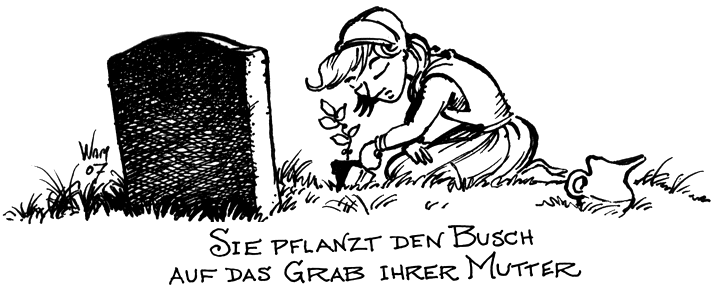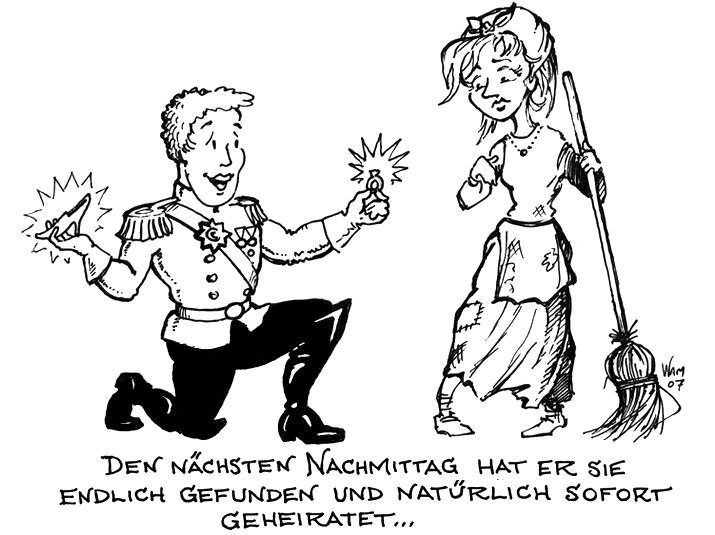2.3.1.3: der Akkusativ
( \newcommand{\kernel}{\mathrm{null}\,}\)
Das direkte Objekt (the direct object)
The accusative case is used to describe the direct object of a sentence. The direct object is the immediate recipient of an action or event:
| Aschenputtel verliert ihre Mutter. | Cinderella loses her mother. |
| Ihr Vater bringt Aschenputtel ein Reis von einem Haselbusch. | Her father brings Cinderella a branch from a hazelnut bush. |
| Sie pflanzt den Busch auf das Grab ihrer Mutter, die auf dem Busch immer als ein weißes Vöglein erschien. | She plants the bush on the tomb of her mother, who always appears as a little white bird on the hazelnut bush. |
| Natürlich hasst die gemeine, böse Stiefmutter das junge Mädchen, wie das in Märchen notwendig ist. | Of course, the mean, evil stepmother hates the young girl, as it is required in fairy tales. |
| Das junge Mädchen muss die Linsen aus der Asche auslesen, und darf keine schönen Kleider tragen. | The young girl has to sort the lentils from the ashes, and is not allowed to wear any nice clothes. |
| Am Ende heiratet sie aber einen gutaussehenden jungen Königssohn, und wenn sie nicht gestorben sind, so leben sie noch heute ... | At the end, however, she marries a handsome young prince and they lived happily ever after ... |

Definite and indefinite articles in the accusative case
Articles in the accusative case (there is no equivalent of the indefinite article in the plural, since, just like in English, you can't say "a lentils"):
| the | a/an | none | english | |
| masculine | den Königssohn | einen Königssohn | keinen Königssohn | (prince) |
| feminine | die Mutter | eine Mutter | keine Mutter | (mother) |
| neuter | das Mädchen | ein Mädchen | kein Mädchen | (girl) |
| plural | die Kleider | Kleider | keine Kleider | (clothes) |
'Es gibt' and the accusative
Remember that the German phrase for "there is/there are" takes the accusative case:
| In diesem Märchen gibt es ein weißes Vöglein. | In this fairy tale there is a little white bird. |
| Es gibt auch zwei garstige Stiefschwestern. | There are also two beastly stepsisters. |
| Und natürlich gibt es auch einen süßen Königssohn! | And of course there is also a cute prince! |
Accusative prepositions
In addition to indicating the direct object of some sentences, the accusative case is also used with a few prepositions:
durch, für, gegen, ohne, and um
| Aschenputtel geht oft durch die Hintertür in den Garten, um das Grab ihrer Mutter zu besuchen. | Cinderella often goes through the back door to visit her mother's grave. |
| Sie muss alles für ihre Stiefschwestern tun; das ist eine schlimme Zeit für das arme Mädchen! | She has to do everything for her stepsisters; it's a bad time for the poor girl! |
| Ihr fragt, warum sie gegen ihre Unterdrücker nicht rebelliert? Tja, Aschenputtel musste damals als Vorbild moralischer, gottesfürchtiger Güte erscheinen. Sie durfte nichts anderes tun! Sehr verklemmt! | You ask why she didn't rebel against her oppressors? Well, at that time Cinderella had to appear as the model of moral, god-fearing Goodness. She wasn't allowed to do anything else! How repressed (the society, that is)! |
| Ohne den Schuh konnte der Prinz Aschenputtel nicht finden! | Without the shoe the prince couldn't find Cinderella! |
| Als Aschenputtel und der Prinz heiraten, stehen alle um den Altar. Selbst ihre Stiefschwestern sind da. | When Cinderella and the prince marry, they all stand around the altar. Even her stepsisters are there. |
Accusative for telling time
Finally, the accusative case is used to describe specific times:
| Aschenputtel und der Prinz haben die ganze Nacht getanzt. | Cinderella and the prince danced all night. |
| Danach hat der Prinz den ganzen Tag die wunderschöne junge Frau gesucht! | Afterwards, the prince looked for the amazingly beautiful young woman the entire day! |
| Den nächsten Nachmittag hat er sie endlich gefunden und natürlich sofort geheiratet ... | The next afternoon he finally found her and of course married her immediately ... |



